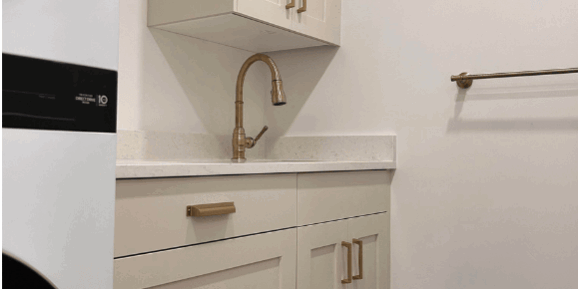Why Remodel Your Basement Laundry Room?
Because laundry is something you do every week — and it shouldn’t feel like a chore. A well-designed basement laundry space can save time, reduce clutter upstairs, and make your home more efficient. You’ll also protect appliances from humidity and improve your basement’s resale appeal.
| Benefit | Impact |
|---|---|
| Better Organization | Custom cabinets, drying racks, and folding counters streamline laundry flow. |
| Increased Home Value | A finished laundry space adds appeal to potential buyers. |
| Improved Efficiency | Energy-efficient lighting and plumbing reduce utility bills. |
| Enhanced Comfort | Good lighting and design make chores less tedious and more enjoyable. |
1. Brighten It Up
Basements are naturally low on sunlight, and when that’s where your laundry room lives, the space can quickly feel gloomy and cramped.
The easiest way to change that? Light — lots of it. A bright, well-lit laundry area not only looks cleaner but also feels bigger, fresher, and far more motivating when you’re tackling endless loads.
| Lighting Element | Purpose | Design Tip |
|---|---|---|
| Recessed LED Lighting | Provides consistent brightness without shadows or glare. | Use daylight (5000K) bulbs for crisp, clean visibility. |
| Under-Cabinet Lights | Illuminates folding areas and counters directly below cabinets. | Choose LED strips with motion sensors for convenience. |
| Light Paint Tones | Reflects light and enhances perceived space. | Use warm whites, pale blues, or soft gray-greige tones for a fresh look. |
- Recessed LED lighting: Provides bright, even coverage that makes the whole room feel open and airy.
- Under-cabinet lights: Perfect for folding, sorting, or stain-treating areas where you need focused light.
- Light paint tones: Whites, pale blues, and soft grays visually expand the space and reflect brightness.
Pro Tip: Use satin or glossy paint finishes — they help bounce light and resist moisture, keeping your laundry room fresh and low-maintenance.
2. Add Built-In Storage
Laundry rooms are functional by nature — but that doesn’t mean they have to look cluttered.
Built-in storage keeps your space polished, practical, and stress-free.
By integrating cabinetry, shelving, and pull-out organizers, you turn your basement laundry into a sleek, efficient workspace that looks designed — not improvised.
| Storage Feature | Function | Design Tip |
|---|---|---|
| Overhead Cabinets | Stores detergent, cleaning products, and paper goods out of sight. | Install soft-close hinges and label baskets inside for easy access. |
| Pull-Out Hampers | Keeps dirty laundry hidden while maintaining organization. | Opt for dual bins to separate whites and colors instantly. |
| Open Shelving | Holds baskets, towels, or décor for an airy look. | Use wood or black metal brackets to complement your design theme. |
- Overhead cabinets: Perfect for keeping detergents and supplies organized and out of reach of kids.
- Pull-out hampers: Hide dirty clothes and free up floor space — no more random laundry piles.
- Open shelving: Great for folded towels, storage baskets, or a touch of greenery.
Pro Tip: Add vertical dividers to store ironing boards, mops, and brooms upright — it keeps them accessible but tidy.
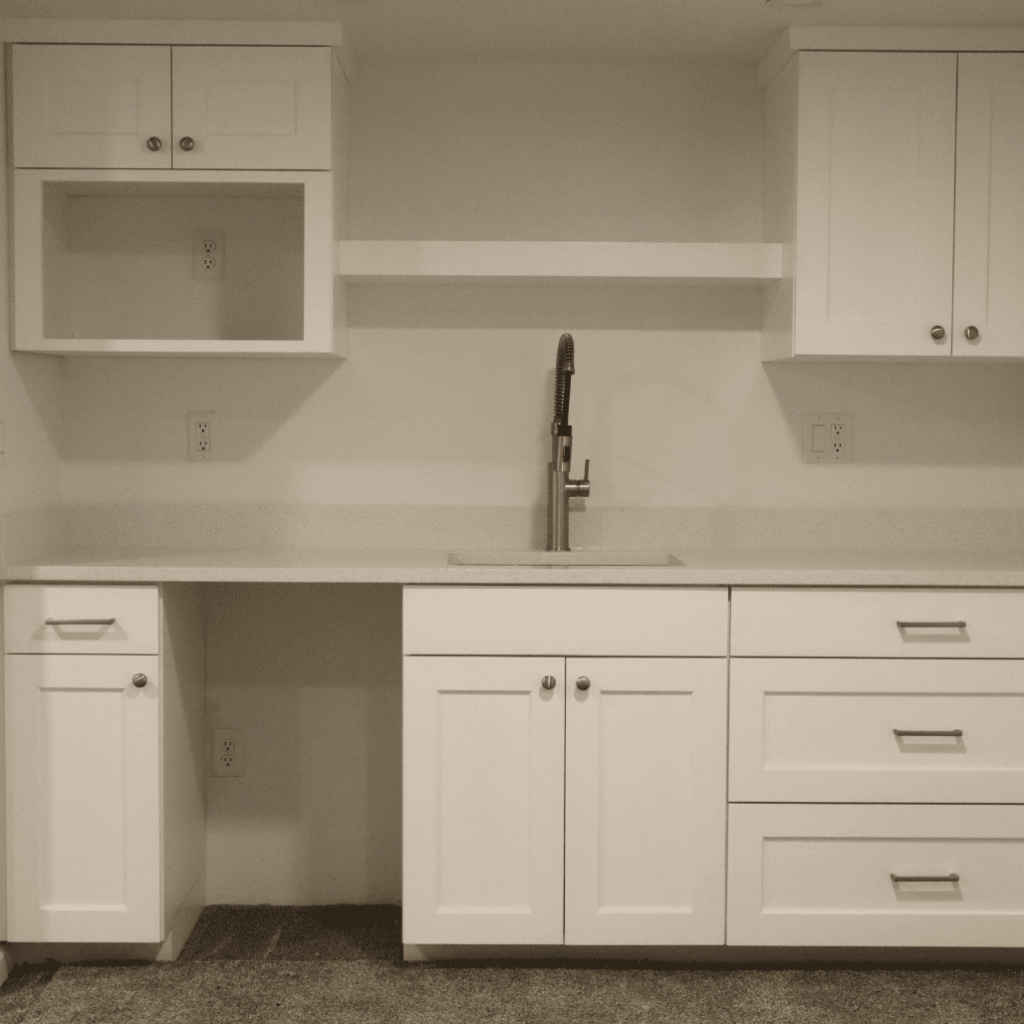
3. Include a Folding Station
Stop using your bed or couch as your folding zone.
A dedicated folding station turns laundry duty into an efficient, ergonomic process — and adds valuable counter space for sorting, treating, or even crafting.
It’s one of the easiest upgrades that makes a laundry area feel professionally designed.
| Counter Option | Benefit | Design Tip |
|---|---|---|
| Countertop Over Washer/Dryer | Maximizes space in small basements. | Install a floating countertop for easy appliance maintenance access. |
| Butcher Block or Laminate | Durable, affordable, and easy to clean after folding or sorting. | Seal the surface to prevent moisture damage from damp clothes. |
| Pull-Out Shelf | Adds flexible workspace in tight layouts. | Use soft-close slides and match finish to cabinets for a built-in look. |
- Countertop over washer/dryer: Saves valuable floor space and keeps everything within reach.
- Butcher block or laminate: A budget-friendly, durable surface that looks upscale and cleans easily.
- Pull-out shelf: Perfect for compact spaces — pull it out when needed, tuck it away when not.
Pro Tip: Add a subtle raised edge (lip) along your counter to prevent folded clothes from sliding off — especially handy on smooth laminate or butcher block surfaces.
4. Upgrade Flooring for Function & Style
Concrete floors might be practical, but they’re cold, slippery, and uninspiring. Upgrading your basement laundry room flooring instantly improves comfort, warmth, and style.
Modern materials can handle moisture, resist scratches, and still look beautiful — transforming the entire feel of your laundry zone from “utility” to “intentional design.”
| Flooring Type | Benefits | Design Tip |
|---|---|---|
| Luxury Vinyl Plank (LVP) | Waterproof, warm underfoot, affordable, and mimics real wood or tile. | Choose light oak or gray tones to brighten the basement visually. |
| Tile with Underfloor Heating | Adds a high-end look while keeping your feet warm on cold mornings. | Opt for matte or textured finishes to prevent slipping when wet. |
| Rubber or Cork Flooring | Soft and forgiving underfoot — perfect for long laundry sessions. | Pick neutral tones and seal cork properly for moisture resistance. |
- Luxury vinyl plank (LVP): A waterproof, low-maintenance favorite that looks like hardwood without the hassle.
- Tile with underfloor heating: Ideal for comfort and design impact — especially in high-end remodels.
- Rubber or cork flooring: Comfortable, slip-resistant options perfect for family laundry areas.
Pro Tip: Choose waterproof baseboards or PVC trim — they’ll protect your walls and prevent swelling or rot from unexpected spills or leaks.
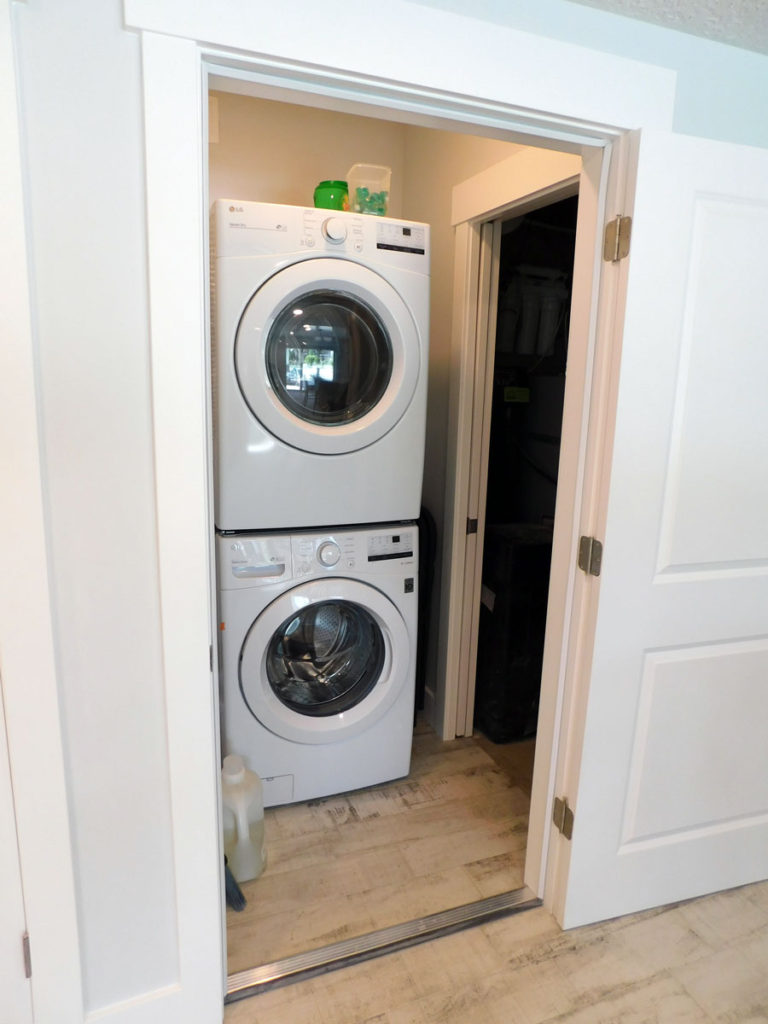
5. Designate a Utility Zone
Basements often double as the home’s most versatile workspace.
Combining your laundry area with a practical utility zone maximizes function and efficiency.
This smart layout keeps all your household essentials — from tools to paint supplies — in one organized, accessible place.
| Feature | Function | Design Tip |
|---|---|---|
| Utility Sink | Perfect for rinsing paint brushes, soaking delicates, or washing muddy shoes. | Install a deep stainless steel or composite sink with a pull-down faucet. |
| Cabinet Storage | Keeps cleaning products, tools, and backup supplies neatly organized. | Use heavy-duty shelves or metal cabinets for durability and easy cleaning. |
| Wall-Mounted Racks | Stores brooms, mops, hoses, and vacuum attachments vertically. | Keep racks near your utility sink for quick cleanup access. |
- Utility sink: Handle messy tasks like rinsing brushes or cleaning sneakers without tracking dirt upstairs.
- Cabinet storage: Organize tools, extra detergents, and seasonal supplies in a clean, concealed way.
- Wall-mounted racks: Free up floor space and keep essentials within easy reach.
Pro Tip: Use durable surfaces — epoxy counters, stainless steel, or sealed concrete — in your utility area to handle water, dirt, and heavy use gracefully.
6. Improve Ventilation & Humidity Control
Basements are naturally prone to moisture — and laundry equipment adds even more humidity.
Without proper ventilation, you risk mold growth, odors, and damage to your appliances over time.
A solid ventilation and humidity control setup ensures your basement stays dry, comfortable, and healthy year-round.
| Solution | Purpose | Implementation Tip |
|---|---|---|
| Exhaust Fan | Removes hot air and moisture created by washers and dryers. | Install near the dryer vent and connect to an exterior wall outlet for maximum efficiency. |
| Dehumidifier | Maintains optimal humidity levels (40–50%) to prevent mold growth. | Use a built-in drain line so you never have to empty the tank manually. |
| Air Vents or Returns | Ensures circulation and consistent air quality throughout the basement. | Connect your laundry area to your home’s HVAC system for continuous airflow. |
- Install an exhaust fan: Removes humid air and prevents mold or mildew buildup behind appliances.
- Dehumidifier: Keeps your basement laundry area dry, fresh, and energy-efficient all year long.
- Air vents or returns: Promote proper airflow and balance temperatures across your basement.
Pro Tip: Install a humidity sensor that automatically triggers your exhaust fan when moisture levels rise — set it and forget it for year-round protection.
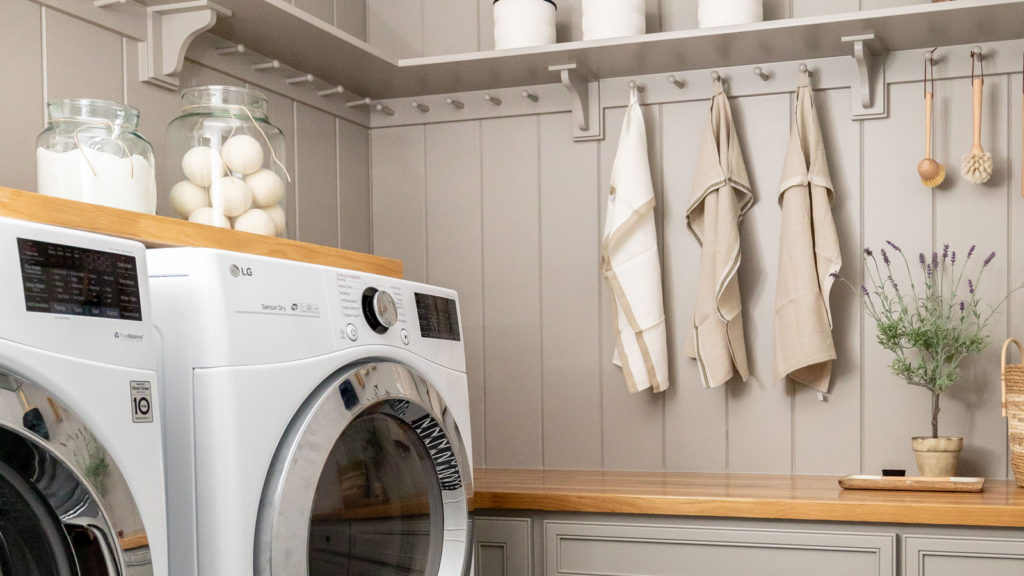
7. Hide the Pipes & Wires (But Keep Access)
A beautiful basement laundry room should look clean and intentional — not like a mechanical room.
However, hiding utilities the wrong way can create problems when it’s time for maintenance.
The trick is concealing plumbing and electrical lines while keeping everything serviceable for future access.
| Method | Benefit | Design Tip |
|---|---|---|
| Removable Wall Panels | Hide plumbing and wiring without sealing them permanently. | Use magnet or Velcro panels for easy removal when service is needed. |
| Painted Conduit or Ceiling Track | Creates a modern, industrial aesthetic while leaving systems exposed. | Paint pipes the same color as your ceiling for a clean, unified look. |
| Drop Ceilings with Tiles | Covers ducts and wires but allows tool-free access overhead. | Choose acoustic tiles with a subtle texture to soften sound. |
- Removable wall panels: Safely conceal utilities but keep them accessible for repairs or inspections.
- Painted conduit or ceiling track: Adds a trendy, loft-style vibe without compromising access.
- Drop ceilings with tiles: Perfect for hiding ductwork while maintaining flexibility.
Pro Tip: Label every hidden access panel — shut-off valves, clean-outs, and junctions — so contractors can find them instantly.
8. Add Style with Details
Who said a laundry room has to look purely functional? Small details make a big visual impact.
With just a few design touches — from backsplash tile to matching containers — you can turn your basement laundry into a space that actually feels part of your home’s interior design.
| Detail | Purpose | Design Tip |
|---|---|---|
| Accent Backsplash | Protects walls and adds a stylish focal point behind appliances. | Try patterned tile, subway, or peel-and-stick options for easy updates. |
| Wall Art or Framed Prints | Brings personality and warmth to a utilitarian space. | Use moisture-resistant frames and cheerful or humorous prints. |
| Matching Baskets or Jars | Creates cohesion and reduces visual clutter. | Use clear or woven containers with uniform labels for a polished look. |
- Accent backsplash: Adds texture and personality to the space — even a small tile strip makes a big difference.
- Wall art or prints: Makes the laundry area feel connected to the rest of your home décor.
- Matching baskets or jars: Bring calm and order — ideal for detergents, pods, or dryer sheets.
Pro Tip: A soft rug or runner adds warmth underfoot and helps absorb sound, instantly making the space feel cozier.
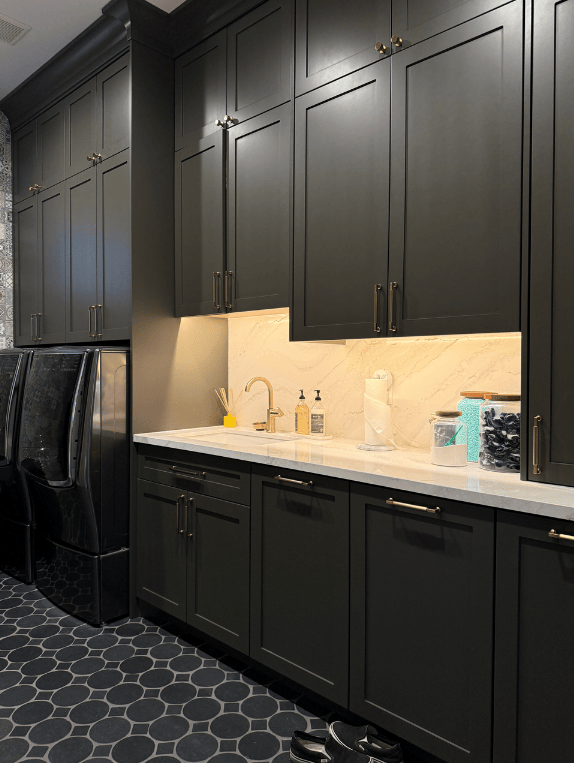
9. Go Smart with Appliances
Laundry technology has come a long way — and upgrading your appliances can save both time and energy.
Today’s washers and dryers are quieter, faster, and far more efficient than older models, making them perfect for basement installations where space and noise control matter.
| Appliance Type | Key Benefit | Design Tip |
|---|---|---|
| Front-Load Washer & Dryer | Stackable to save floor space and reduce bending. | Add pedestals below for hidden storage drawers. |
| Smart Appliances | Wi-Fi enabled for remote control and cycle alerts. | Use smartphone apps to monitor loads and energy use. |
| Energy Star Models | Use less water and power, cutting utility costs long-term. | Look for moisture sensors and quick-wash settings for efficiency. |
- Front-load washer/dryer: Stack to maximize vertical space or raise on pedestals for ergonomic comfort.
- Smart appliances: Manage laundry from your phone and receive alerts when cycles finish.
- Energy Star models: Lower utility bills while being gentler on fabrics and the environment.
Pro Tip: Mount a floating shelf or slim cabinet above your machines to store laundry pods, décor, or cleaning tools while maintaining a streamlined look.
10. Combine Function with Comfort
Laundry may never be fun, but the right atmosphere can make it far more pleasant.
Adding a few comfort features turns your basement laundry room into a space you actually don’t mind spending time in — a calm, practical retreat rather than a dark chore zone.
| Comfort Feature | Purpose | Design Tip |
|---|---|---|
| Seating Nook | Offers a place to rest, fold clothes, or wait for cycles. | Use a bench with storage drawers or cushions that match your palette. |
| Plants or Greenery | Adds color, freshness, and natural air purification. | Pick low-light varieties like snake plants or pothos. |
| Music or Small TV | Makes laundry time more enjoyable and helps the space feel lived-in. | Mount speakers or a compact smart TV out of splash range. |
- Seating nook: Add a cozy bench or chair for folding, sorting, or a quick break between cycles.
- Plants or greenery: Brighten up the basement naturally and boost air quality.
- Music or small TV: Keep the mood light — a little entertainment goes a long way.
Pro Tip: Echo upstairs design details — matching trim, color palette, or lighting style — to make your basement laundry feel like a seamless extension of your home.
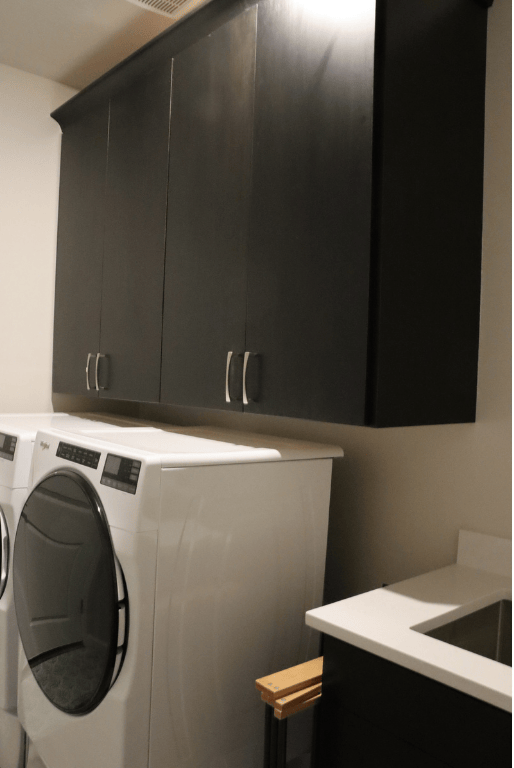
Basement Laundry Remodel Cost Breakdown
A basement laundry or utility room remodel typically costs between $8,000 and $25,000+ depending on finishes, layout, and plumbing needs.
| Feature | Average Cost (USD) | Notes |
|---|---|---|
| Flooring Upgrade | $1,000 – $4,000 | Vinyl, tile, or cork materials. |
| Lighting & Electrical | $800 – $3,000 | LED lighting, outlets, and task lights. |
| Cabinetry & Storage | $2,000 – $6,000 | Custom or modular units for organization. |
| Appliance Upgrades | $1,500 – $4,000 | New energy-efficient washer/dryer sets. |
| Plumbing or Utility Sink | $1,000 – $3,000 | Includes fixtures and drain connections. |
| Ventilation / HVAC | $800 – $2,000 | Dehumidifier and exhaust systems. |
| Finishes & Decor | $500 – $1,500 | Paint, backsplash, and trim work. |
| Total Range | $8,000 – $25,000+ | Varies by scope and finish quality. |
Basement Laundry Design Tips
- Use moisture-resistant materials: Basements are humid — waterproof everything.
- Keep flow in mind: Washer → Dryer → Folding → Hanging → Storage should move logically.
- Plan outlets carefully: You’ll need dedicated circuits for washers and dryers.
- Consider noise control: Insulate walls if your laundry shares space with bedrooms.
- Add a drain pan: Prevents water damage in case of leaks.
Bring Style and Function to the Basement
Your laundry and utility areas don’t have to be dull. With a thoughtful design, smart materials, and the right lighting, your basement can transform into a stylish, high-performance space that makes everyday life easier.
Pro Worx Construction specializes in basement remodels across Utah — including laundry, storage, and multi-purpose spaces that balance beauty with practicality. Let’s design a basement that works harder for you.
Get a Free Laundry Room Remodel Quote
Because even laundry day deserves a beautiful space.
Frequently Asked Questions
How much does it cost to remodel a basement laundry room?
Most remodels range from $8,000–$25,000 depending on size, plumbing, and materials.
What flooring is best for basement laundry areas?
Luxury vinyl plank, tile, or sealed concrete — all waterproof and easy to clean.
How can I improve basement laundry lighting?
Install recessed LEDs, under-cabinet lighting, and choose bright, reflective finishes.
Can I combine laundry and utility functions?
Yes — combine with a utility sink, cabinets, and tool storage for maximum efficiency.
Do I need a permit for plumbing or electrical upgrades?
Yes, any major electrical or plumbing changes usually require local building permits.
Additional Resources:
Top 10 Basement Renovation Ideas
Cost to Finish a Basement in Utah


